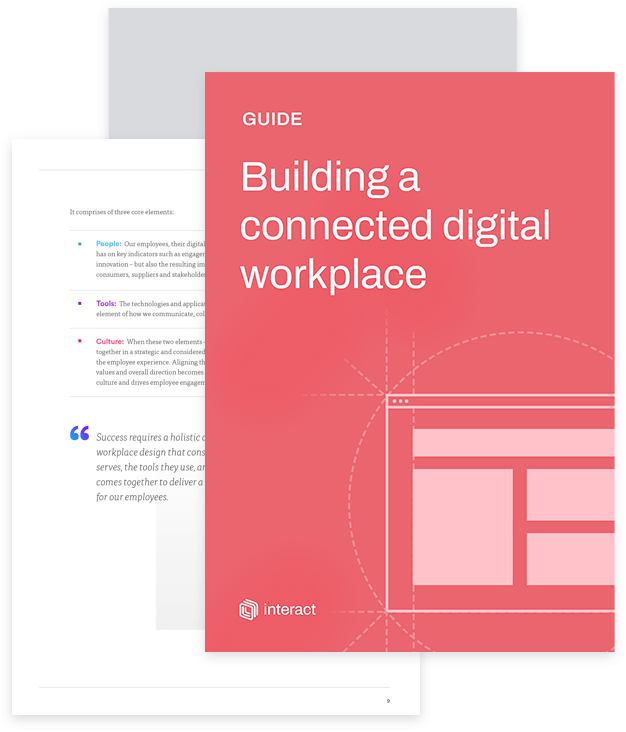Are you ignoring these 5 essential digital trends?

Keeping up with continually changing digital trends is never easy. From new technology to fresh strategies, it’s difficult to know what’s next up for you and your organization. Knowing this, how can you be sure you’re not ignoring the trends crucial to your digital workplace?
A year has gone by since the many predictions made for the future of 2018 and industry improvements have continued to develop, adding to the list of trends covered. While many of the previous trends are still on the rise and making their mark on the industry, new trends have begun to make their way into the folds.
With all these fundamental shifts happening in the digital landscape, deciding on the “right” digital trends to partake in has become a process full of wins and losses.
Digital trends and your workplace
While many organizations desire to upgrade to all the latest trends, they are held back by the natural restrictions of things like time, budget and other resources. Some may have enough time to try, fail, or succeed at these ventures, while others are forced to be a bit more picky about which trends to take the risk on.
The cycle of change continues whether we jump on the movement or not, which means that your industry and how you do business will surely be affected.
Building a connected digital workplace
To ensure the changing digital landscape works for you (not against you) and helps maintain your competitive edge, here are 5 digital trends you cannot ignore.
Video
If you haven’t experienced the benefits of the ever-growing video trend, then it’s time to start now. Marketers have been predicting the importance of video for years with Cisco projecting that global internet traffic from videos will make up 80% of all internet traffic by 2019.
Video allows brands to showcase their authenticity and transparency, engage with viewers on a deeper level, and show more of the ins and outs of their services so that viewers get a closer look at what the organization has to offer. Plus, videos are simply more eye-catching and easier to share via social platforms than more traditional methods.
It’s not about merely creating a video; it’s about understanding the best methods and various types of video necessary to tell the story best. Because of its versatility, video is seen as a dominant marketing tool through the use of things like live streams, vlogs, video ads, and much more. The possibilities are endless and to take advantage of this trend to the max, professionals must use these videos to share everything from employee stories to the process behind how their products or services are made.
We need to understand the various types of videos and how best to leverage them to tell stories, explain a product, and share a live event. The two most essential video types for marketers to master are live streaming and six-second video ads.
In addition, knowing how to effectively compress a video can also prove beneficial. This process allows marketers to make their videos smaller in size without compromising on the quality. Hence, making it more accessible and easy to share across various digital platforms.
Social Tools and Influencers
In the age where information overload is the norm and consumers are bombarded with something new every day, it can be difficult to know what to trust. While the majority of the world knows not to believe everything they read on the internet, the same does not apply to word of mouth. People love user testimonials and providing real-life accounts that are backed up by real individuals is a powerful strategy.
People crave authenticity and what better way to give it than to share real-life experiences with the public. This is where your employees come in. Hearing news from management just does not have the same effect as getting it straight from the source. Social tools create an opportunity for your staff members to become influencers, power players in your digital strategy.
7 useful tips for retaining your employees
As platforms that are crucial to everyday life for a number of people, businesses have a responsibility to integrate social tools into their organizational strategy. In fact, almost three-quarters (73%) of respondents agree that their companies are ‘combining digital marketing skills with technology.’
On top of the more popular consumer sites like Twitter or Pinterest, business social apps like Slack, Yammer, and Trello connect your distributed employees and give users an opportunity to communicate and share stories with individuals across the globe.
Digital skills and education
As digital trends grow and organizations advance, employees run the risk of falling behind if neglected. When it comes to a strict budget, it is tempting to neglect the training and skill-building of your staff in favor of more critical tasks. However, the long-term benefits of raising and advancing your staff far outweigh any temporary setbacks.
Because of technological advancements, skills are now linked to digital workplace platforms. To be sure that your staff is being the most productive that they can be, why not provide training that would assist them. Organizations can ensure they are keeping staff up-to-date with the latest trends through things like online training courses or even third-party technology vendors or training agencies.
Digitally based certification programs, training applications, and learning management systems are only a few of the methods necessary to engage and retain your tech generations. These systems have the power to enrich your training programs with attention-grabbing features like video, audio-based training, and polls.
Training does not need to be lengthy and time-consuming. Consider Microlearning, a technique that condenses training into short bursts of learning activities that range from 2-15 minutes in length. This microscopic version of learning provides short, convenient, and easily accessible training to your staff.
What better way to elevate at a rapid pace than to take advantage of the mobility provided by e-learning?
AI
The biggest and maybe most talked about digital trend is one that people have been predicting for ages. From your classic Terminator movies to the actualization and creation of these ideas, AI technology has grown massively over the past few years.
We see it in our everyday lives with products like Siri and Amazon Echo, and employees expect to see it in their workplaces.
Luckily, AI is already helping marketers in many different ways, including creating content rapidly, increasing communication with customers with chatbots, and acting as a source of knowledge based on its broad base of data sources. AI is more than just time-saving. AI technology like chatbots has strong potential for business application, especially in internal communication fields. Able to be present 24/7 with a wealth of ever-growing knowledge, bots can be utilized in the moments that real humans cannot.
Although real-world, personal application of AI is almost commonplace, the adoption for business settings is still a work in progress. In many situations, a sense of humanity is welcome or even necessary, but AI capabilities are advancing every day and professionals are better understanding the proper ways to assimilate it into the current method of working.
There’s no doubt that digital trends will continue to evolve. If you are not actively trying new things and adopting new processes, then you are simply falling behind. Stay ahead of the curve with these five tips and assure your organization’s spot among the top players in your industry.


